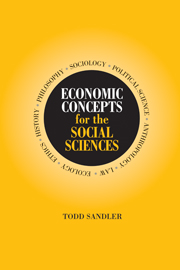Book contents
- Frontmatter
- Contents
- Table and Figures
- Preface
- 1 Economics without Apology
- 2 Back to the Future: Political Economy
- 3 In Another's Shoes: Games, Strategies, and Economics
- 4 It Takes Two or More: Public Economics and Collective Action
- 5 Government for the Politician? Public and Social Choice
- 6 Institutions Matter: The New Institutional Economics
- 7 Knowledge Is Power: Asymmetric Information
- 8 Everything Ties Together: General Equilibrium
- 9 Laboratory Economics: Of Rats and Men
- 10 Before Yesterday and Beyond Tomorrow: Intergenerational Economics
- 11 Fish, Space, and Spaceship Earth: Bioeconomics and Interdisciplinary Economics
- 12 Crystal Ball Economics: Rational Expectations
- 13 How Do We Get There from Here? Transition Economies and Policy Reforms
- 14 Economic Growth: Endogeneity, Institutions, and Other Concepts
- 15 Economic Visions of Future Horizons
- References
- Author Index
- Subject Index
3 - In Another's Shoes: Games, Strategies, and Economics
Published online by Cambridge University Press: 14 May 2010
- Frontmatter
- Contents
- Table and Figures
- Preface
- 1 Economics without Apology
- 2 Back to the Future: Political Economy
- 3 In Another's Shoes: Games, Strategies, and Economics
- 4 It Takes Two or More: Public Economics and Collective Action
- 5 Government for the Politician? Public and Social Choice
- 6 Institutions Matter: The New Institutional Economics
- 7 Knowledge Is Power: Asymmetric Information
- 8 Everything Ties Together: General Equilibrium
- 9 Laboratory Economics: Of Rats and Men
- 10 Before Yesterday and Beyond Tomorrow: Intergenerational Economics
- 11 Fish, Space, and Spaceship Earth: Bioeconomics and Interdisciplinary Economics
- 12 Crystal Ball Economics: Rational Expectations
- 13 How Do We Get There from Here? Transition Economies and Policy Reforms
- 14 Economic Growth: Endogeneity, Institutions, and Other Concepts
- 15 Economic Visions of Future Horizons
- References
- Author Index
- Subject Index
Summary
Open any modern-day textbook in economics and you will see game boxes and game trees used to explain the strategic interaction among diverse economic agents. It matters not whether it is a macroeconomics text addressing policy making, or a public finance text analyzing how people voluntarily contribute to a public good. This methodological revolution has swept economics during the last two decades. When I completed my doctorate in 1971, game theory had barely been mentioned, and when it had been discussed, the reference had usually been disparaging. My first exposure to this tool came in the early seventies when, as an assistant professor at Arizona State University, I took mathematics classes from Albert Tucker and Evar Nering. These great mathematicians had been at Princeton University during the days when game theory was being developed as a mathematical tool for the social sciences. There had been high hopes during the 1940s and early 1950s that this development would provide all of the social sciences with a unifying theoretical base, from which great insights would spring. A driving force behind this development was a brilliant mathematician – perhaps the brightest of the twentieth century – named John von Neumann. This self-absorbed, totally focused individual first developed his game-theoretic ideas in papers published in 1928 and 1937. His quickness and brilliance were legendary, but then so was his single-minded dedication to his work. Albert Tucker, his ex-colleague at Princeton, once illustrated von Neumann's consuming and humorless focus with the following story. Von Neumann had come to Tucker for a name for John's latest monograph on an esoteric geometry that contained no points.
- Type
- Chapter
- Information
- Economic Concepts for the Social Sciences , pp. 33 - 55Publisher: Cambridge University PressPrint publication year: 2001
- 1
- Cited by



